#Wildlife Act 1953
Quote
Threatened species, even when classed as nationally critical like the Eyrewell beetle, aren’t automatically protected by law. The Wildlife Act can apply to species on private land if they're specified in the act - but there's a catch. When the act was written in 1953, it focused on animals, and back then insects weren’t considered as animals. Some insects have since been added as honorary animals but the now possibly extinct Eyrewell beetle isn’t among them. If by chance any more beetles are found on private land, their fate depends on the landowner’s mercy.
Farah Hancock, ‘Aotearoa’s vanishing species’, RNZ
#Threatened species#Farah Hancock#RNZ#Aotearoa#New Zealand#Eyrewell beetle#Wildlife Act 1953#animals#insects#private land#legal protection
1 note
·
View note
Text
Character Profile — New Zealand
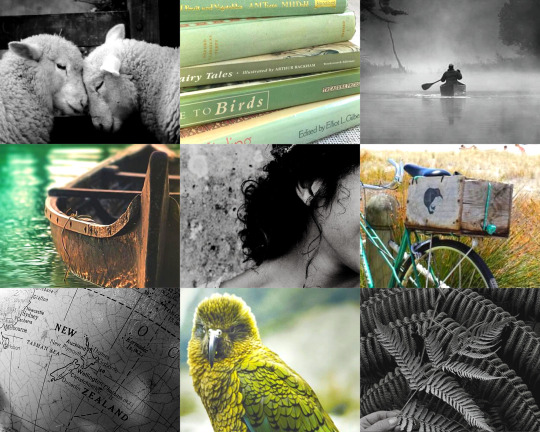
Character Name: Aotearoa, New Zealand. Zee, Kiwibird, Kiwifruit, Dearest Eleanor, Darling Eleanor. 1810 - 1967 - Eleanor Elizabeth Rose Kirkland 1967 - ???? - Aroha Eleanor Kaipo.
Age: Baby, toddler, child. 1800-1867. Preteen 1867-1880. Teenager, 1880-1900. Appears about 18-21 after 1907. Before then, about 2-3 years younger than Jack.
Height: 165 cm, 5'5.
Physical Description: Always round-faced and chunky as a baby, Zee grew to be a very athletic young woman who dove into sports from the first time she held a ball and shed corsets the first chance she got. She has the ideal body for rugby, wide-hipped with a low center of gravity. It takes much exertion, but she's got enough human strength to haul one of her gigantic brothers. She spent her early adulthood in corsets and was stuck in a strict gender binary, so she has a lot more grace and poise than the grubby flanno shirt and gum boots would betray when she's in the paddocks these days. She can appear very cranky and cold; her default expression is sour, but when she smiles, she lights the room up.
Eye colour: Dark brown eyes that look slightly green or gold when she's wearing a larger Pounamu/greenstone pendant but are unconditionally brown.
Hair colour/style: She has an incredible amount of dark curly hair that she generally wore long until 1915 and has worn in various styles since then, generally around her shoulders after 1930. She didn't have to use rollers when those were fashionable; she could form her hair into stylish rolls and waves. She's worn it somewhat longer in the new millennium and experimented with various braids and styles, especially reviving Māori knot and twist styles. Still, a long braid over one shoulder often feels most familiar.
Other distinguishing physical traits: Her hair tends to be one of her trademarks, but she inherited her father's brows and freckles, which got her caught by Arthur when she was in uniform as a male.
Personal Appearance/Style: She loves black clothing way too much. She always preferred being in mourning clothes before 1900 so that people would leave her the fuck alone in public. She wore a lot of Jack's clothes growing up. She likes fashion and keeps an eye on new styles, and she wears green a lot, generally a darker jewel-tone green for more formal occasions overseas. At home, it's a lot of bare feet, cargo shorts, t-shirts and water sports. She has worn the Korowai for formal occasions since the mid-20th century. She's had the Tā moko done several times, but she's a nation, so it fades, and she has to get it redone.
Verbal Style: Due to sex and ethnicity, Zee learned to switch much more easily between accents and languages to whatever will give her the most advantage in a situation. She can code-switch between te reo Māori, her default broad New Zealand accent and a relatively posh accent that doesn't quite ring upper-class British after WW2 but certainly reflects her education and commonwealth status.
Level of Education: Of Arthur's children, she has the most history of formal education. She received an educational equivalent of a BA in the 1890s at Oxford before women could actually receive a diploma; her graduation present was her right to vote in 1893. She attended Florence Nightingales Nursing College in London and graduated in 1906, her graduation present being her and Arthur signing her law of formal dominionship into law. She went back to Oxford after WW1 to get a degree in Social work and Anthropology in 1924, and finally went to medical school in the 1930s and qualified as a surgeon by 1934. In 1939, anticipating the coming war, she trained as a pilot specializing in navigation. It was only in the 1950s that she finally enrolled in engineering courses but ended up in a graduate program for Ornithology (study of birds) after the 1953 Wildlife Act.
Occupation: She has some work she does for the government, but generally, she rotates between social work, conservation work with her birds and some diplomacy work.
Past Occupations: Military nurse, sapper, subaltern, social worker, archaeologist, anthropologist, flight nurse, surgeon, GP sheep rancher, agricultural and mechanical engineer, flight navigator, pilot, diplomat and conservationist.
Skills Abilities or Talents: As far as special nation abilities go, as a Polynesian seagoing culture, she almost always knows exactly where she is no matter what hemisphere, just automatically. She's never gotten lost in her life. Also, when she's angry, her islands tend to show slightly more volcanic activity than usual, primarily geysers. She's second only to Alfred in sheer natural prowess at practically anything she wants to try. Has very little aptitude for the creative arts, however.
Admirable Personality Traits: Tenacious, observant, intelligent, compassionate, logical and resourceful.
Negative Personality Traits: Judgemental, self-righteous, and often too logical and sharp-tongued.
Sense of Humor: Sharp, ironic, sarcastic, a bit twisted and darker than it should be.
Physical/Mental illness or affliction: Generally the most stable of her siblings, sex and national rep status sometimes combine in really weird ways, and her moods and hormones tend to fluctuate in such a way that even Jack, someone who regularly handles the world's deadliest predators and poisonous creatures might hesitate and will not attempt it unless armed with food, chocolate and much compassion because good god does she deal with so much shit as a woman and a country.
Hobbies/Interests: Bungee jumping, zorbing, bird watching, surfing, mountain climbing, sailing, gardening, ziplining, reading and rugby.
Favourite Foods: Fish and chips, pavlova, hāngī.
Most important personal item: Her collection of Taonga Māori, mostly her Pounamu/greenstone pendants, but also carvings she has in her home, combs, her Korowai and kākahu cloaks and a Wahaika she's had her entire life.
Person/friend close to character: Her next oldest brother, Jack, is her best friend and closest family member and the person she probably loves most in the world, if often to her own chagrin. Also, close to Taiwan. Has an evolving, often unequal but also close relationship with other Pacific and Polynesian nations due to her status as an imperial power in the region.
Brief family history: Born in the very early 19th century, Arthur claimed her and took permanent possession after 1840. In the structure Arthur raised her in, she was the last child and only daughter, has 3 elder brothers, her father, 2 uncles and an aunt. Her situation is much more unclear than her 'siblings' because she has always had Māori looks and kept their traditions and culture close to her heart. And she's not sure how that relates her to other Polynesian cultures because she was born of fucked up structures, and that made her incredibly different than many of her island peers. Her father sees much of his mother, a pre-Roman figure in her, but that always annoys her a bit.
Most painful experiences in the character’s past: Chunuk Bair, the Sinking of the HMS Marquette, Passchendaele, the mount Erebus disaster in 1979, where she was killed on her way to Antarctica and earthquakes in 1931, and the Spanish Flu in 1918.
Their Song: Birds, by Imagine Dragons & Elisa
#Character Sheets || bodies and flesh of borders and fences#zee || ahakoa he iti he pounamu#hws new zealand
35 notes
·
View notes
Text
Fast Facts: Prince Philip
CNN Editorial Research
September 13, 2022

Personal
Birth date: June 10, 1921
Death date: April 9, 2021
Birth place: Corfu, Greece
Birth name: Prince Philip of Greece and Denmark
Father: Prince Andrew of Greece and Denmark
Mother: Princess Alice of Battenberg
Marriage: Queen Elizabeth II (20 November 1947- 9 April 2021, his death)
Children: Edward, Earl of Wessex (10 March 1964); Andrew, Duke of York (19 February 1960); Anne, Princess Royal (15 September 1950); King Charles III (14 November 1948)
Military: British Royal Navy, 1939-1953
Other Facts

Full title: HRH The Prince Philip, Duke of Edinburgh, Earl of Merioneth and Baron Greenwich, Knight of the Garter, Knight of the Thistle, Order of Merit, Knight Grand Cross of the Order of the British Empire, Companion of the Order of Australia, Companion of The Queen’s Service Order, Privy Counsellor.
His ancestry is not Greek by blood, but English, Russian, German/Prussian, and Danish.
The youngest of five children and the only son.
A third cousin of his wife, the Queen, and like her, he is a great-great-grandchild of Queen Victoria.
His interests were painting, environmental conservation, horses, flying, and sailing.
He has written books on birds, the environment, carriage driving, and other subjects.
After earning his RAF wings in 1953, Philip logged more than 5,900 hours in 59 different types of aircraft over the next 44 years.
Timeline

1922 - The overthrow of his brother, King Constantine I of Greece, causes Prince Andrew, Princess Alice and their five children to leave Greece and settle in Paris.
1930 - After his parents’ separation in 1930, Philip is sent to England and raised there by his maternal grandmother and uncle.
1940 - Serves as a midshipman, his first posting, on the HMS Ramillies of the Mediterranean Fleet.
1942 - Becomes a sub-lieutenant in the British Royal Navy.
July 1942 - Promoted to first lieutenant and executive officer aboard the HMS Wallace, a destroyer, and participates in the Allied landings in Sicily during World War II.
February 1947 - Becomes a naturalized British citizen and a commoner, using the surname Mountbatten, an English translation of his mother’s maiden name.
Prior to taking the British oath of citizenship, being sixth in line to the throne of Greece, he renounces all claims to titles in both Greece and Denmark.
July 10, 1947 - King George VI and Queen Elizabeth announce Elizabeth’s engagement to Philip.
November 19, 1947 - Invested as a Knight of the Order of the Garter and is given the titles of Duke of Edinburgh, Earl of Merioneth and Baron Greenwich.
November 20, 1947 - Marries Princess Elizabeth at Westminster Abbey.
His name changes from Lt. Philip Mountbatten to His Royal Highness Prince Philip, Duke of Edinburgh.
1948 - Appointed as a personal aide-de-camp to his father-in-law, King George VI.
1950 - Promoted to lieutenant-commander.
June 1952 - Promoted to commander, but his naval career ends with the death of King George VI and his wife’s ascension to the throne on February 6.
1953 - Appointed admiral of the fleet, field marshal of the Army and marshal of the Royal Air Force.
Designated regent presumptive by an act of parliament.
In the event of the Queen’s death or incapacitation, Philip would rule as regent for Prince Charles.
1956 - Launches the Duke of Edinburgh’s Award, which rewards children for achievements in personal development and community involvement.
1956-1970 - Serves as president of the Royal Yachting Association.
1957 - By Queen’s decree, is “granted style and titular dignity of a Prince of the United Kingdom.”
He is invested as a Grand Master and First or Principal Knight of the Order of the British Empire.
This decree restores his birth title of prince.

1961-1981 - First president of the World Wildlife Fund - UK.
1964-1986 - President of the International Equestrian Federation.
June 1968 - Awarded the Order of the Merit by the Queen, an honor bestowed to those of “great achievement in the fields of the arts, learning, literature, and science.”
Restricted to 24 members.
1975-1980 - Serves as president of the Royal Yachting Association for the second time.
1981-1996 - Serves as president of World Wildlife Fund International.
1996-present - President Emeritus of the World Wildlife Fund.
April 9, 2005 - Philip and the Queen are the only senior members of the royal family who do not attend Charles and Camilla Parker-Bowles’ civil wedding ceremony. They do attend the dedication service.
November 10, 2005 - His 58th wedding anniversary makes him the longest-serving British consort, outliving the wife of King George III, Queen Charlotte.
October 23, 2006 - Inspects British forces in southern Iraq.
May 3-8, 2007 - Philip and the Queen visit the United States for the 400th anniversary of America’s first British settlement in Jamestown in 1607.
They attend the Kentucky Derby on May 5 and a state dinner at the White House on May 7.
April 1, 2009 - Along with the Queen, meets US President Barack Obama and First Lady Michelle Obama at Buckingham Palace.
June 10, 2011 - His 90th birthday makes him the oldest-serving royal consort.

December 23-27, 2011 - Undergoes treatment for a blocked coronary artery at Papworth Hospital.
June 4-9, 2012 - hospitalized for a bladder infection at King Edward VII Hospital in London.
He misses part of the Jubilee celebrations commemorating the Queen’s 60th anniversary on the throne.
August 15-20, 2012 - Treated at Aberdeen Royal Infirmary for a bladder infection.
June 7-17, 2013 - A patient in London Clinic having been admitted for abdominal pain, he has exploratory surgery the following day and is released following his recuperation.
January 26, 2015 - Australian Prime Minister Tony Abbott awards that nation’s top honor, Knight of the Order of Australia, to Philip for his life of service throughout the Queen’s reign.
May 4, 2017 - Buckingham Palace announces that Philip will step down from public life after August 2017.
August 2, 2017 - Attends a parade of the Royal Marines at Buckingham Palace, carrying out the last of his thousands of public appearances before stepping back from public life.
April 3, 2018 - Philip is admitted to a London hospital to undergo planned surgery on his hip.
January 17, 2019 - Involved in a traffic accident when his car collides with another vehicle carrying two women, aged 28 and 45, as well as a nine-month-old baby boy.
In a statement the following day, a spokesperson said the Duke of Edinburgh had a “precautionary check-up on doctor’s advice that confirmed Philip had no injuries of concern.”
It is later announced that he will not face any charges over the accident.
February 9, 2019 - Buckingham Palace announces that Philip has surrendered his driving license following his January traffic accident that left a female driver injured.
December 20, 2019 - Philip is admitted to the hospital over a “pre-existing” condition, according to a statement from Buckingham Palace.
He leaves the hospital on December 24.
April 20, 2020 - Philip makes a rare public statement thanking those working across the UK to help tackle the coronavirus pandemic.
February 16, 2021 - Philip is taken to a London hospital after feeling unwell, according to a statement from Buckingham Palace.
On March 3, he undergoes a medical procedure for a heart condition.
March 16, 2021 - Philip leaves King Edward VII’s Hospital where he was recovering and returns to Windsor Castle, according to a statement from Buckingham Palace.
April 9, 2021 - Dies at the age of 99.
September 8, 2022 - Queen Elizabeth II dies, and Charles ascends to the throne.

🖤🤍🖤
#Prince Philip#Prince Philip of Greece and Denmark#Duke of Edinburgh#British Royal Family#royal consort#oldest-serving royal consort#Queen Elizabeth II
2 notes
·
View notes
Text
Events 7.7 (After 1900)
1907 – Florenz Ziegfeld Jr. staged his first Follies on the roof of the New York Theater in New York City.
1911 – The United States, UK, Japan, and Russia sign the North Pacific Fur Seal Convention of 1911 banning open-water seal hunting, the first international treaty to address wildlife preservation issues.
1915 – The First Battle of the Isonzo comes to an end.
1915 – Colombo Town Guard officer Henry Pedris is executed in British Ceylon for allegedly inciting persecution of Muslims.
1916 – The New Zealand Labour Party was founded in Wellington.
1928 – Sliced bread is sold for the first time (on the inventor's 48th birthday) by the Chillicothe Baking Company of Chillicothe, Missouri.
1930 – Industrialist Henry J. Kaiser begins construction of Boulder Dam (now known as Hoover Dam).
1937 – The Marco Polo Bridge Incident (Lugou Bridge) provides the Imperial Japanese Army with a pretext for starting the Second Sino-Japanese War (China-Japan War).
1937 – The Peel Commission Report recommends the partition of Palestine, which was the first formal recommendation for partition in the history of Palestine.
1944 – World War II: Largest Banzai charge of the Pacific War at the Battle of Saipan.
1946 – Mother Francesca S. Cabrini becomes the first American to be canonized.
1946 – Howard Hughes nearly dies when his XF-11 reconnaissance aircraft prototype crashes in a Beverly Hills neighborhood.
1952 – The ocean liner SS United States passes Bishop Rock on her maiden voyage, breaking the transatlantic speed record to become the fastest passenger ship in the world.
1953 – Ernesto "Che" Guevara sets out on a trip through Bolivia, Peru, Ecuador, Panama, Costa Rica, Nicaragua, Honduras, and El Salvador.
1958 – US President Dwight D. Eisenhower signs the Alaska Statehood Act into law.
1959 – Venus occults the star Regulus. This rare event is used to determine the diameter of Venus and the structure of the Venusian atmosphere.
1962 – Alitalia Flight 771 crashes in Junnar, Maharashtra, India, killing 94 people.
1963 – Buddhist crisis: Police commanded by Ngô Đình Nhu, brother and chief political adviser of South Vietnam President Ngo Dinh Diem, attacked a group of American journalists who were covering a protest.
1978 – The Solomon Islands becomes independent from the United Kingdom.
1980 – Institution of sharia law in Iran.
1980 – During the Lebanese Civil War, 83 Tiger militants are killed during what will be known as the Safra massacre.
1981 – US President Ronald Reagan nominates Sandra Day O'Connor to become the first female member of the Supreme Court of the United States.
1983 – Cold War: Samantha Smith, a US schoolgirl, flies to the Soviet Union at the invitation of Secretary General Yuri Andropov.
1985 – Boris Becker becomes the youngest male player ever to win Wimbledon at age 17.
1991 – Yugoslav Wars: The Brioni Agreement ends the ten-day independence war in Slovenia against the rest of the Socialist Federal Republic of Yugoslavia.
1992 – The New York Court of Appeals rules that women have the same right as men to go topless in public.
2003 – NASA Opportunity rover, MER-B or Mars Exploration Rover–B, was launched into space aboard a Delta II rocket.
2005 – A series of four explosions occurs on London's transport system, killing 56 people, including four suicide bombers, and injuring over 700 others.
2007 – The first Live Earth benefit concert was held in 11 locations around the world.
2013 – A De Havilland Otter air taxi crashes in Soldotna, Alaska, killing ten people.
2016 – Ex-US Army soldier Micah Xavier Johnson shoots fourteen policemen during an anti-police protest in downtown Dallas, Texas, killing five of them. He is subsequently killed by a robot-delivered bomb.
2019 – The United States women's national soccer team defeated the Netherlands 2–0 at the 2019 FIFA Women's World Cup Final in Lyon, France.
2022 – Boris Johnson announces his resignation as leader of the Conservative Party following days of pressure from the Members of Parliament (MPs) during the July 2022 United Kingdom government crisis.
1 note
·
View note
Text
City of Crystal River

The view from atop Temple Mound A allows one to experience what the Native Americans who lived here may have seen thousands of years ago. This is a National Historic Landmark in Crystal River. Image by Diane Bedard.
Crystal River Archaeological State Park highlights History
Along the northwest edge of the City of Crystal River is home to a National Historic Landmark consisting of the Crystal River Archaeological State Park. This pre-Columbian Native American site containing burial mounds, temple mounds, a plaza area, and a sizeable shell midden is worth a visit from anywhere.
This 61-acre Native American site was occupied long before Columbus came to America; in fact, evidence has been found that puts native peoples living at this site from the Deptford period (800 BC), the Swift Creek-Santa Rosa culture and up to the late Fort Walton period (1500 AD). It is one of the longest continuously occupied sites in Florida with many stories to tell.
Artifacts found at the site are displayed in the museum and Park Rangers give historic demonstrations throughout the year.
Native peoples who lived at, and visited, the site that houses the Crystal River Archaeological State Park were able to hunt and gather food from the sea (oysters, saltwater fish), land (deer, bear, beaver), and marsh (turtles, freshwater fish) in this area.
These native peoples built six large middens, mostly consisting of oyster shells and bones from fish and animals that provided their food, layered with sand and plant debris.
Some of these mounds were used to bury the human remains also, and it is believed that over 7,500 Natives lived or visited here. Evidence of trading with other tribes has been found. This is a peaceful place to visit, with explanatory displays, demonstrations and trails to roam. There are several archaeological finds, and activities to help history come alive.
Crystal River Preserve State Park
Next to the Archaeological Park is the Crystal River Preserve State Park, with a fantastic historical boat tour each Monday, Wednesday and Friday run by the Park’s Friends organization. The boat tour allows visitors the opportunity to see the islands and temple mounds of the time gone by. It can make it easier to visualize how this historic society operated. There are interpretive exhibits. Coincidentally, the archaeological excavations began in 1903.
Today the Florida Public Archaeology Network of USF has an office at the Crystal River State Preserve.
An historic and nature-viewing tour is available at the Crystal River State Park, put on by Friends' of the Park, it offers another view into ancient civilizations, the opportunity to see native wildlife and a relaxing cruise that supports the park and its activities.
The City of Crystal River
After the Second Seminole War and the Armed Occupation Act of 1842, twenty-two men filed for land in Crystal River. Several families moved to the area after the Civil War. The turpentine industry brought more people to the area, with William Turner being a noted early resident.
If you’ve ever written with a Dixon pencil, you are using a piece of Crystal River’s history. The cedar mill that made the planks those pencils were made from was located to Kings Bay in 1882. Those boards were shipped to New Jersey to make Dixon pencils.
The Crystal River Train Depot is alongside the walking/biking path.
1888 brought the railroad to Crystal River, providing a way for wealthy northerners to come to Crystal River to sport fish and starting the area’s thriving tourism business.
The Crystal River Nuclear Plant
During excavations for the Florida Nuclear Power Plant in 1969, scientists discovered rhinoceros and mastodon bones, as well as the shells of an extremely large armadillo and a large land tortoise.
Bones were found from the Pleistocene era, giving evidence that the Crystal River area had sabre-toothed tigers and mastodons roaming on it. Image is of a diorama from 1953 and is from FloridaMemory.com
The power plant was completed and licensed to operate in December 1976, and operated safely for 33 years until shutdown in September 2009. It was the third plant built as part of the 4,700-acre River Energy Complex (CREC) that includes four fossil fuel power plants.
In 2009, the Crystal River nuclear plant was shut down for “routine maintenance.” During the maintenance, the reactor was cracked and determined to be inoperable. In 2014, the plant was closed. This caused a serious change in the employment outlook for the City of Crystal River.
Visiting Crystal River
The Plantation on Crystal River was built in the 1960s and has been updated and renovated many times over the years because its bones and location are so wonderful.
The Plantation Inn and Golf Resort was built in 1962 along the banks of the pristine Crystal River. In 1975, W.W. Caruth Jr. purchased the property, impressed with its beautiful natural setting and Old South charm. Today, this beautiful resort offers fine dining, manatee and scalloping tours, fishing charters, a riverside pool area, three golf courses, and an on-site spa. It has plenty of history in the area and is a premier place for getting away on the Nature Coast.
Crystal River Trolley stop
The Edwards House
Heritage Village
Cattle Dog Coffee Roasters Crystal River location.
On eo fth ecute downtown Crystal River shops.
The City of Crystal River's Charming Downtown
In 2015, Crystal River became a Main Street community.
The downtown area has many repurposed historic homes that now house shops, restaurants, galleries, and service businesses.
The area near Citrus Avenue and US 19 is home to Heritage Village, which encompasses the Eubanks Edwards House (c.1900) and several early rental cottages. Directly across Citrus Avenue, quaint businesses welcome visitors and residents. Historic buildings, quaint lighting, and colorful landscaping welcome shoppers daily.
Hundreds of manatees come to Kings Bay for the "warm" water in the winter. Image courtesy of Citrus County Visitors Bureau.
Manatee Tours and Three Sisters Springs
Over the years, Crystal River has become most well-known for its manatee tours. Citrus County is the only place one can swim in the water with manatees legally. There are many tour operators that provide complete packages for this amazing encounter. Some of our favorites can be found here.
The Three Sisters Springs manatee viewing attraction is open daily and trolleys run on weekends between downtown Crystal River and the viewing area.
Three Sisters Springs in Crystal River is one of the most beautiful places to see manatees and it was saved from development in 2010 and became part of the Crystal River National Wildlife Refuge. Boardwalks have been built around the Springs and now you can visit daily 8:30-4:30 for a fee. Trolley tours take visitors from the boardwalk area to downtown Crystal River as part of the admission fee.
Manatees are easily seen from the boardwalk in Hunters Springs Park.
Several public parks are located throughout Crystal River. Hunters Springs was recently updated and given a beautiful boardwalk and kayak launch, along with playground equipment and picnic provisions. The only fee is for parking and the manatees are easy to spot from the boardwalk.
Festivals and Events celebrate Crystal River
There are many festivals and events held in Crystal River throughout the year. To see what's happening now, check out NatureCoaster's events page.
Divers floating in the spring. This picture is just so beautiful that I had to include it. Courtesy of Miles Sanders, Citrus County Visitors and Convention Bureau.
Read the full article
1 note
·
View note
Link
Because of this change of position by the US Army Corps of Engineers to require an environmental impact statement, I doubt whether this new pipeline will ever be built. If not, that raises the important issue of the degradation of the existing pipeline. Inevitably, it will have to be closed. So, this move effectively kills the idea of a pipeline flowing under the Straits where Lake Michigan and Lake Huron join. If I’m right, then an environmental win, but it will take a few years to be realized. During which, hopefully nothing catastrophic will happen.
Excerpt from this story from Grist:
Under the turbulent waters of the Great Lakes, a 68-year-old pipeline is transporting 540,000 barrels of crude oil each day, despite Michigan Governor Gretchen Whitmer’s order that Enbridge Energy shut down the pipeline by May 12.
For several years, one of Enbridge’s main arguments for continuing to operate the pipeline, Line 5, was that it would soon build a tunnel to encase the riskiest portion of the pipeline, the part that crosses through the Straits of Mackinac. The Straits of Mackinac is an environmentally sensitive channel connecting Lake Michigan to Lake Huron, and a spill from the aging pipeline would be devastating to the local economy, ecosystem, and drinking water. The risk of such a spill is what pushed Whitmer to revoke Enbridge’s right to operate the pipeline. But Enbridge has said its proposed tunnel, which it said it planned to start building this year, will protect the waters from any potential spill.
“Placing a pipeline in a new Great Lakes Tunnel will provide extra layers of safety and environmental protection and make what is currently a safe pipeline even safer,” Enbridge said in a statement emailed to Grist.
Last week, however, federal officials made a decision that casts severe doubt on Enbridge’s optimistic timeline, increasing the likelihood that the Line 5 pipeline will eventually be shut down for forever.
The U.S. Army Corps of Engineers, the federal agency that regulates civil works projects, is now going to require Enbridge to conduct an environmental impact statement for the proposed construction of the tunnel, instead of the more surface level “environmental assessment” that Enbridge initially proposed doing. Under the National Environmental Policy Act, or NEPA, an environmental impact statement is required if a proposed federal project is determined to significantly affect the environment.
“This would be the first federal NEPA analysis that [Line 5] would be subject to, ever,” said Oday Salim, a lawyer for the National Wildlife Federation, a nonprofit conservation organization that works to protect the Great Lakes. “It really does affect everything,” he told Grist.
Because the pipeline, built in 1953, predates certain environmental laws, it has never before been subject to an environmental impact statement.
Enbridge has acknowledged that this environmental review will delay construction of the tunnel, calling into question the idea of the tunnel as a quick fix.
10 notes
·
View notes
Text
Queen of the Pinups: Bettie Page
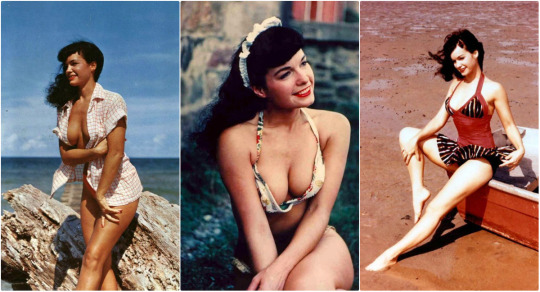
Betty Mae Page, better known as Bettie Page was one of the most popular pin ups during the 1950s. She was exotic, sexy, and photogenic, casting a spell on anyone who looked her way. She could be shy, playful, even fierce, and rightfully earned her title “Queen of the Pinups”. But then she just vanished. Her face was everywhere but she was nowhere to be found, just what happened?
On the Coney Island beach in the early 1950s she was scouted by photographer Jerry Tibbs, he handed her a card and told her she would make a beautiful pinup. He shot her portfolio free of charge and suggested that she should have bangs to keep light from reflecting off her forehead. She became popular in ‘Camera Clubs’, taking risky photos, but this was only the beginning.
Starting in 1951 she began working as a model for Irving Klaw, starring in a mix of pinup and BDSM shoots. Here she also starred in special films for specific clients, making soft core pornography. One of these most famous videos was of Page tied up and being lashed by a mistress before spanked. She gained another title ‘Queen of Bondage’ at this time.
Then in 1953 she took acting classes at Herbert Berghof studios, hoping for a big break. Her wait was short. She starred in a handful of films, television shows, and off Broadway productions. Soon after she met photographer H.W. Hanau and Bunny Yawger.
This photo shoot at the Africa USA wildlife park in Florida her most iconic ‘Jungle Bettie’ photos were taken. This included nude shots with two cheetahs. This shots were sent to Playboy Magazine and earned Page the title Playmate of the Month January 1955. This recognition earned her more titles, Dark Angel, Miss Pinup Girl World, and Queen of Curves. But then in 1957 the train derailed, and she faded.
This sudden departure earned many rumors, such as a man dying during a bondage shoot. But Page claims she thought God did not approve of the nude images, and she devoted her life to him.
After her modeling days her life spiraled. In the early 1960s she tried to become a Christian Missionary, but was rejected due to being a divorced woman. She enrolled in college in hopes of achieving a masters degree, but dropped out. She then married and divorced again.
In 1978 her life finally caught up with her, she had a mental breakdown and was evaluated before diagnosed with schizophrenia. She then spent just under two years in Patton State Hospital. After being released she got into an altercation with her landlord and was arrested for assault, but let go due to reasons of insanity. She was placed under state supervision and finally released in 1992.
In December of 2008 Page was hospitalized, for what reason was fuzzy. Some news organizations said it was a heart attack while others claimed it was pneumonia. On the 11th her family decided to take her on life support.
Page was a beautiful woman who touched many people's lives, but just as she tumbled into the spotlight she left it. Next time we’ll talk about the lawsuit that finally allowed her to collect royalties on her own image.
27 notes
·
View notes
Text
Kea
Although Kea are protected within New Zealand by laws that prohibit their capture, mistreatment, and export, parrot-smuggling is a lucrative business and kea are captured for the black market pet trade.
#FaunaFocus #Kea #Keas
Although Kea are protected within New Zealand by laws that prohibit their capture, mistreatment, and export, parrot-smuggling is a lucrative business and kea are captured for the black market pet trade.
The kea has been fully protected by national law since 1986.
Kea are protected within New Zealand by the Wildlife Act of 1953, the National Parks Act, the Animals Protection Act, and the Trade in…

View On WordPress
4 notes
·
View notes
Text
My Pictures for Schools - Hertfordshire
In Hertfordshire the County Council’s collection of pictures for schools was started in 1949 as part of the School Loan Collection, a post-war initiative by Sir John Newsom, the Hertfordshire Chief Education Officer at the time. The aims of Pictures for Schools were to provide education for children, show children contemporary art rather than reproductions of masters and to liven up classrooms that in post-war Britain would have needed modernisation.
Many of the pieces were purchased from reputable dealers, artists and the ‘Pictures for Schools’ exhibitions which took place from the 1950s and 1960s. I thought I would show some of the pictures I now own and put the biographies of the artists.
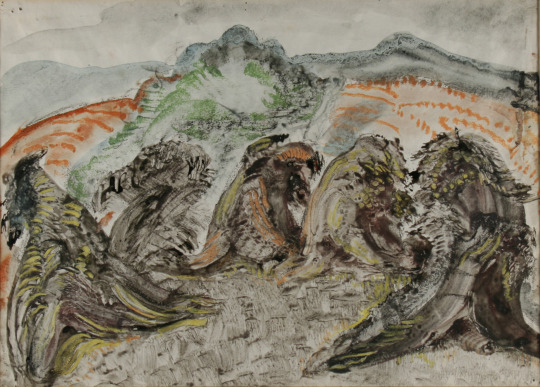
Vera Cunningham - 'Stooks',
Born in Hertfordshire of Scottish parentage, Vera studied painting at the Central School of Arts and Crafts. She began exhibiting with the London Group in 1922. With Matthew Smith, she exhibited in Paris at the Amis de Montparnasse and the Salon des Indépendants in 1922. Her first one-man show was held at the Bloomsbury Gallery in 1929. She produced a number of theatre designs at the end of the 1930s, but returned to easel painting. During WWII she was involved in the Civil Defence Artists' shows at the Cooling Galleries. After the war her Paris dealer, Raymond Creuze, mounted three exhibitions in 1948, 1951 and 1954. She lived in London. The Barbican Art Gallery held a retrospective exhibition in 1985. Her work is held in the Manchester City Art Gallery; the Guildhall Gallery, London and at Palant House, Chichester.
Cuningham modeled for and had relationships with fellow artists Bernard Meninsky and Matthew Smith.

Vera Cunningham - 'Garden Scene',
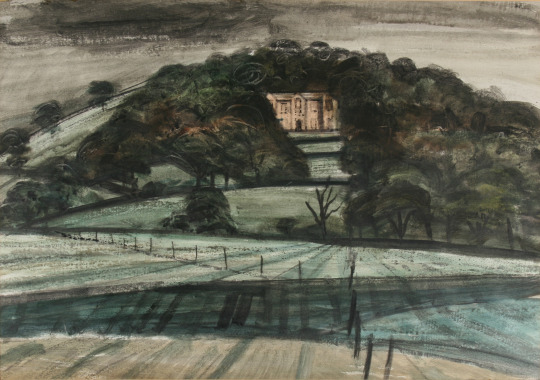
Thomas William Ward - 'Charmouth Manor'
Thomas William Ward, was born at Sheffield. Studied part-time with Eric Jones (Harold Jones's twin brother) at Sheffield 1937-1939. After service during the Second World War, Bill continued his studies at the Royal College of Art 1946-1950, winning a silver medal in 1949. He married at Kensington, London in 1949, sculptor Joan Palmer Ward. He taught at Harrow College of High Education 1950-1980, finally as principal lecturer, retiring to Suffolk in 1980. Elected a member of the Royal Society of Painter Etchers in 1953 and the Royal Society of Painters in Watercolour in 1957. This painting was bought from Whitworth Art Gallery, Manchester in 1957.

Alistair Grant - 'The Weight-lifter'
Although best known as a printmaker, Alistair Grant also painted throughout his career and in the 1980s he adopted an expressionist style using vibrant colours. He was born in London and studied at Birmingham College of Art (1941-43). After serving during the war, Grant returned to art school and the Royal College of Art, where he was taught by Carel Weight and Ruskin Spear. Grant was to work in the printmaking department of the Royal College for 35 years (1955-90), ending his career as Emeritus Professor of Printmaking at the RA.
The Weight-lifter was bought from the Whitechapel Art Gallery at their Pictures for Schools exhibition: 8 October – 29 October 1949. It is likely ‘Eva’s House’ came from a similar exhibition.
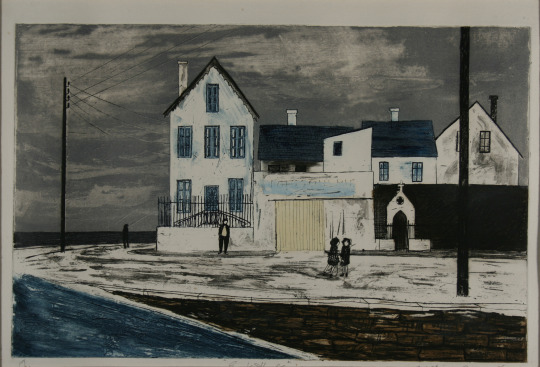
Alistair Grant - 'Eva's House', 1955

Vincent Lines - 'Old Hereford Wagon',
Vincent Lines was awarded a scholarship to the Royal College of Art in 1928. The principal, William Rothenstein described him as ‘one of the best students of the painting school’. While only in his twenties, he was appointed principal of Horsham School of Art and later became principal of Hasting School of Art. Lines was a prolific and talented topographical watercolourist, with an intimate knowledge of the countryside, which he recorded on the spot, in the open air.
He was chosen as an artist for the Recording Britain project, to which he contributed twenty watercolours. He was a close friend of Thomas Hennell and the pair often painted together in the countryside around Hennell’s home at Ridley, near Meopham in Kent.
Lines survived the war and went on to become Vice-president of the Royal Watercolour Society. He wrote the biography of Mark Fisher and Margaret Fisher Prout, illustrated Rex Waites ‘The English Windmill’
The war years brought deepened friendships in particular with Mildred Eldidge and Thomas Hennell, both fellow watercolourists of the R .W .S . Through contact with Hennell he became fascinated by country crafts and together they hunted out the potter and the cooper, wheelwright and blacksmith, hurdlemaker and charcoal burner.
During 1943-4 he painted a series of eight watercolours recording the avenues of elms in Windsor Park, before the trees were felled. The pictures are now in the Royal collection. A further commission for Vincent during these years was the contribution to Arnold Palmer’s four-volumed Recording Britain, published in association with the Pilgrim Trust.
Due to Thomas Hennell’s death in 1945 the illustration of Rex Wailes’s book The English Windmill, which would certainly have been done by him, passed instead to Vincent Lines. Wailes’s definitive survey presents English windmills in their history, construction and mode of working.
Resurgence Magazine Issue 141, Jul 1990.

Molly Field - 'Farm Implements'
Molly Field was born in Keighley, Yorkshire. She originally worked under the name Molly Clapham but then married the artist Dick Field. Attended Leeds College of Art (1932-33) then the Royal College of Art (1934-38), with Ernest Tristram. Showed at the Royal Academy, Women’s International Art Club and the Wakefield. Also known under Mary Field.
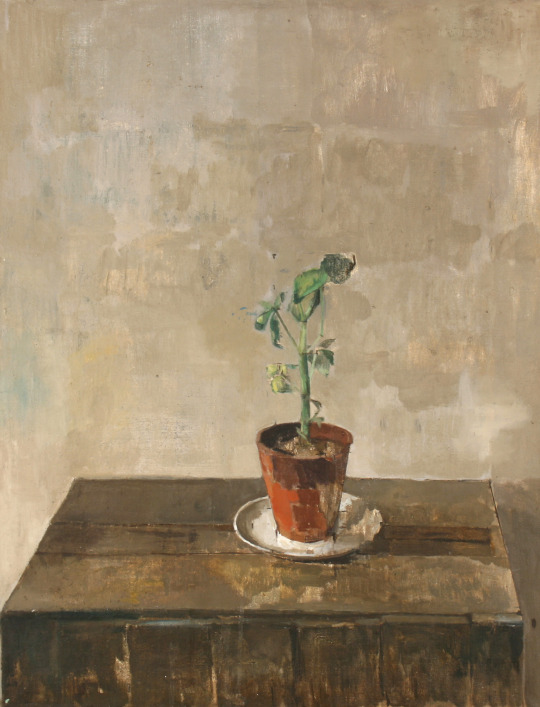
M Murphy - 'Geranium'
This is a mystery as it is one of the best paintings in the collection but there is no detail in the archives about who it is by.

Berard Gay - 'Ivy Plant'
Bernard left school at the age of 14 and after various jobs, just before the Second World War joined the merchant navy. In 1947 that he returned to education, studying textile part-time at the Willesden School of Art (1947-52) and changed course to fine-art under Maurice de Sausmarez and Eric Taylor. He began drawing classes at St Martins School of Art and quickly established himself as a painter. It may have been in the Pictures for Schools exhibition 23 January – 14 February 1954.

David Koster - 'Cat and Lilies'
Koster studied at the Slade School of Art (1944-47). Taught drawing and print-making at Medway College of Design. One-man shows at Everyman Foyer Gallery (1958, 60, 62, 64, 66, 68, 70); Glasgow Citizen's Theatre (1965); Stable Theatre Gallery, Hastings (1967). Taken several illustration commissions including work for the RSPB and a front cover for their 'Birds' Magazine.
David Koster was born in London and attended the Slade School of Fine Art from 1944 to 1947. He was a founder Member of the Society of Wildlife Artists in 1964.

Raymond Croxon - 'View in the Lake District',
Raymond Coxon enrolled at the Leeds School of Art, and the Royal College of Art. While he was there, between 1919 and 1921, he not only met his future wife but also became friends with a fellow student, Henry Moore. In 1922 Moore and Coxon visited France and met a number of artists there, including Pierre Bonnard and Aristide Maillol. Coxon continued his studies in London at the Royal College of Art between 1921 and 1925 under Sir William Rothenstein. Coxon took a teaching post at the Richmond School of Art in 1925 and in 1926 he married Edna Ginesi, with Moore acting as his best-man. Coxon would later perform the same service for Moore when he married Irina Radetsky in July 1929. He became a member of the London Group in 1931 and of the Chiswick Group in 1938.
During the WW2 he became a war artist and was commissioned to produce some paintings of Army subjects in Britain. Then working for the Royal Navy as a war artist. The painting of this print is in the collection of Palant House. The lithograph made for the Contemporary Lithographs Ltd. Other artists in the series were Eric Ravilious, John Piper, Vanessa Bell, Barnett Freedman and so on.

Julia Ball - 'East Coast Storm'
Julia Ball is a Cambridge artist and this woodcut came up for sale with the Cambridge collection of Pictures for Schools but due to a cataloguing error on the auctioneers I didn’t win it as they had labeled it as a different lot. For years I smoldered about that. But when the Hertfordshire sale came up, I had to have it. Made in the 1960s this woodcut is of a storm over the east coast. Her painting are mostly abstract and works can be found in Kettles Yard and in the New Hall art collection. This picture was bought from the Royal Academy Diploma Galleries, 1967.
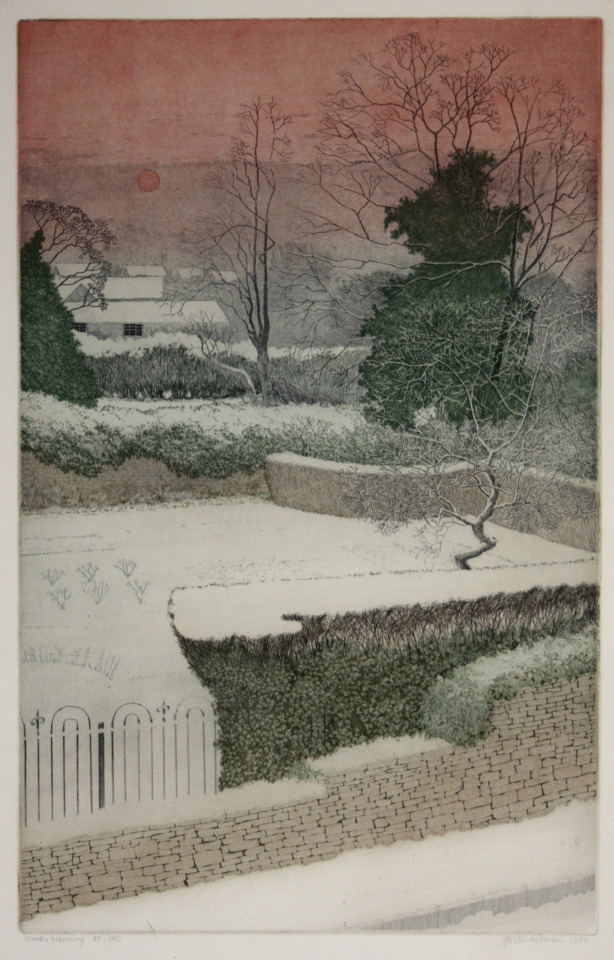
Joseph Winkelman - 'Winter Morning'
Joseph Winkelman has specialised in intaglio printmaking since 1975 after completing the Oxford University Certificate course in Fine Art at the Ruskin School of Drawing. As an active member of the Royal Society of Painter-Printmakers (RE), he served as President from 1989 to 1995 and was recently artist in residence at St John's College, Oxford.

John Sturgess - 'Black and White Leaf'
A student at the Royal College of Art in the 1950s. He would have been taught by Julian Trevelyan, Edwin La Dell, Edward Ardizzone and Edward Bawden. He worked with John Brunsdon as a printer, printing other artists work, rather than going into teaching. They set up a press in Digswell Art Centre and that is likely how his work ended up in the Hertfordshire Collection. This work of a leaf looks more like foil, it is rather beautiful and a lithograph on stone. Though I haven’t photographed it the frame is a John Jones frame made of aluminium and is as beautiful as the print.

John O'Conner - 'Boy and the Heron'
John O'Connor A.R.C.A. R.W.S, is today best known for his woodcuts, but during his lifetime he was also celebrated as a watercolourist. In 1930 he enrolled at Leicester College of Art before moving on to the Royal College of Art in 1933. His teachers at this time were Eric Ravilious, John Nash and Robert Austin. He graduated in 1937.
On a visit to Eric Ravilious’s home at Bank House, Castle Hedingham in Essex, O'Connor was captivated both by the directness of the wood-engraving technique, and by the simple domestic scene in which Ravilious engraved by a lamp in one corner of the room while his wife Tirzah played with their small son by the fire in another. It was due to Ravilious that O'Connor got his first commission of work aged 23, illustrating Here’s Flowers by Joan Rutter for the Golden Cockerel Press in 1937.
He taught at Birmingham and Bristol before serving in the Royal Air Force form 41-45. On being demobbed he illustrated two books for the Golden Cockerel Press and taught in Hastings for two years before moving to Colchester to become the head of the School of Art in 1948. He was affectionately known as ‘Joc’ to his students, using his initials. His colleagues included Richard Chopping, who designed dust jackets for the James Bond novels, his own former teacher John Nash, and Edward Bawden, one of the finest British printmakers.
He saw his favourite painting places in Suffolk - the ponds, willows, briars and honeysuckle - disappear beneath the bulldozer and combine harvester. In 1964 O'Connor retired from teaching full time at Colchester, to concentrate on painting and engraving. He wrote various 'How to’ books and taught part time at St Martin’s School of Art. In 1975 he and his wife, Jeannie, went to live by Loch Ken in Kirkcudbrightshire, where his love of light and water inspired his many watercolours and oil paintings. He took up a post teaching at Glasgow School of Art from 1977 to 1984.
In the 1950s and 60s, O'Connor exhibited at the Zwemmer Gallery, in London, and had many exhibitions throughout Britain. His work was purchased by the Arts Council, the Tate Gallery, the British Museum and the Contemporary Art Society, as well as by several local education authorities; it can also be found in the Oslo Museum, the Zurich Museum and at New York central library. He was elected to the Royal Society of Painter-Etchers and Engravers in 1947, and, in 1974, to the Royal Watercolour Society. He was an honorary member of the Society of Wood Engravers.

June Berry - 'High Meadow'
June Berry studied painting at the Slade School of Fine Art, London. She has had nineteen solo exhibitions including a retrospective at the Bankside Gallery, London in 2002. Her paintings have been exhibited frequently at the Royal Academy Summer Exhibition, London since 1952. Berry was Vice-President of the Royal Watercolour Society from 2001 to 2004.
Her work is included in the collections of HM the Queen, the British Government Art Collection, the Victoria & Albert Museum, London, the National Museum of Wales, the Royal West of England Permanent Collection, the Graphothek, Berlin, Germany and the All Union Society of Bibliophiles, Moscow, Russia. Her work has also been purchased by many private collectors in the UK, USA, Germany and Russia. She is a Member of the Royal Watercolour Society, the Royal Society of Painter-Printmakers, the New English Art Club and is a Royal West of England Academician.

Madeleine Holtom - 'Orchids'
Madeleine Elizabeth Anderson was born in Belvedere, Kent. She studied art at the Kingston School of Art where Reginald Brill was principal with other teaching from Anthony Betts, William Ware and John Platt. In 1932 she was awarded a scholarship to study at the Royal College of Art, there she won the painting prize in 1934. She painted in oils and watercolours under William Rothenstein and Gilbert Spencer.
Leaving the RCA she became a professional artist and also worked making advertisements. She married and divorced G. H. Holtom and they had two sons and two daughters, they moved to Northwood near Watford, North-West London.
She also exhibited with the New English Art Club.
Her work is represented in the collections of: Friendship House, Moscow. Queen’s College, Oxford. The Cuming Museum. Cheltenham’s Art Gallery. The Government Art Collection, British High Commission, Accra, Ghana.

Frank Freeman - 'Flower Piece',
Frank Freeman is a bit of a mystery to me at the moment. I can find mention of him in a few places but sadly due to the blitz and poor archiving many are the lost. What is known is he was supported for a while by Lucy Carrington Wertheim and he was based in the Manchester area. One flower painting is mentioned in her book Adventure in Art.
Visitors who came to see me about this time. Among these were Frances Hodgkins, who stayed for months at a time at my flat, Henry Moore and his lovely Russian wife, John Skeaping, Barbara Hepworth, Cedric Morris, Lett Haines, John Alford, William Plomer, Leon Underwood, John Gould Fletcher, Pavel Tchelitchew, Komisarieysy, David Fincham and his wife Sybil, Jim Ede and Frank Freeman.
Lucy Carrington Wertheim - Adventure in Art, 1947 p10-11

John Wynne-Morgan - 'Christmas Roses'
John Wynne-Morgan was born in Harrogate, Yorkshire and enrolled at the Heatherley School of Fine Art in London in 1945.
In a 1962 London catalogue foreword, Wynne-Morgan is described as ‘primarily a portrait painter’ (though the show contained scenes of Paris, Ibiza, Venice and London, and he also painted many Bonnard-ish nudes). His studio was in Hampstead and he was the author of three books for aspiring artists. In Oil Painting as a Pastime: A Complete Course for Beginners (Souvenir Press, London, 1959), he evokes how hard it is to embark on a portrait:

Edna Rodney - 'Parrot Tulips'
Of all the artists I bought Edna Rodney eludes me, I can not find her anywhere and it might be she was an art student who gave up art for a family or she might have been one of Hertfordshire’s pupils that ended up in the collection as sometimes happened. It is rare to find nothing however.
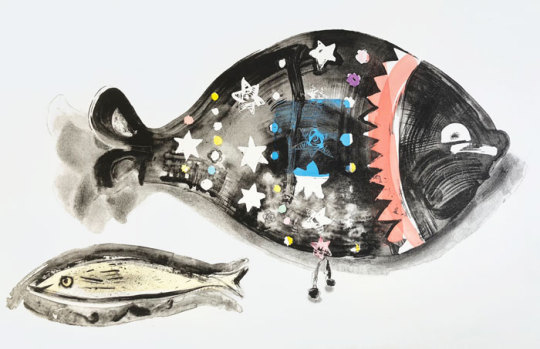
Chloë Cheese - 'Lucky Fish',
Chloëʼs childhood was spent in the Essex village of Great Bardfield observing the printmaking of her mother Sheila Robinson and she remembers in particular often visiting the studios of fellow printmakers Edward Bawden and Michael Rothenstein.
She has contributed to a recent book Bawden, Ravilious and the Artists of Great Bardfield published by the V&A. Chloë studied at Cambridge Art School from 1969 and the RCA from 1973 to 1976.
She has lived in South London since the 70s, investigating her home and surroundings first through drawing which is then used as a basis for the creation of monoprints, lithographs and etchings. Her engagement with still life subjects has widened to include figures against the palimpsest of an urban life.
Chloë has exhibited widely and her work is held in various public collections including The V and A Museum London and The Arts Council of Great Britain.
Bio via St Judes.

Chloë Cheese - 'Pink Carnations',
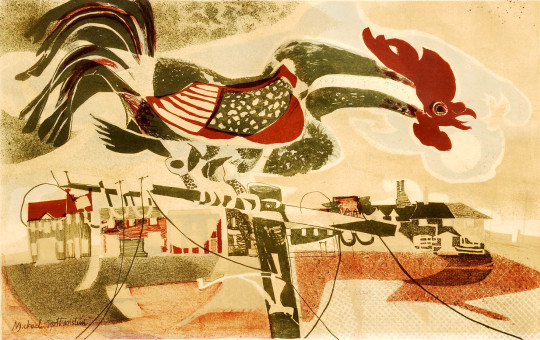
Michael Rothenstein - 'Coronation Cockerel'
Born in Hampstead, London, on 19 March 1908, he was the youngest of four children born to the celebrated artist, Sir William Rothenstein and his wife Alice Knewstub. He studied at Chelsea Polytechnic and later at the Central School of Arts and Crafts. Affected by lingering depression, Rothenstein did little art making during the late 1920s and early 1930s. Despite this, he had his first one-man show at the Warren Gallery, London in 1931.
During the late 1930s the artist's output was mainly Neo-Romantic landscapes and in 1940, like Vincent Lines, he was commissioned to paint topographical watercolours of endangered sites for the Recording Britain project organised by the Pilgrim Trust. In the early 1940s he moved to Ethel House, in the north Essex village of Great Bardfield.
At Great Bardfield there was a small resident art community that included John Aldridge, Edward Bawden and Kenneth Rowntree. In the early 1950s several more artists (including George Chapman, Stanley Clifford-Smith, Audrey Cruddas and Marianne Straub) moved to the village making it one of the most artistically creative spots in Britain. Rothenstein took an important role in organising the Great Bardfield Artists exhibitions during the 1950s. Thanks to his contacts in the art world (his older brother, Sir John Rothenstein, was the current head of the Tate Gallery) these exhibitions became nationally known and attracted thousands of visitors.
From the mid-1950s Rothenstein almost abandoned painting in preference to printmaking which included linocut as well as etchings. Like his fellow Bardfield artists his work was figurative but became near abstract in the 1960s.
Although little known as a painter, Rothenstein became one of the most experimental printmakers in Britain during the 1950s and '60s.
Rothenstein was elected an Associate of the Royal Academy (ARA) in 1977 and a Royal Academician (RA) in 1984. Near the end of his life there was a retrospective of his work at the Stoke-on-Trent City Museum and Art Gallery (1989) and important shows followed at the Fry Art Gallery, Essex.
The print I have (The Cockerel) was made for the Festival of Britain series of prints in 1951 and is signed under the mount. Likely bought from Redfern Galleries.

My blog of some of my pictures from the Cambridgeshire Collection of Pictures from Schools is here.
For areas of research I am indebted to Catherine Davis and Natalie Bradbury.
#Michael Rothenstein#Chloe Cheese#Pictures for Schools#Vera Cunningham#Alistair Grant#Vincent Lines#Molly Field#Berard Gay#David Koster#Raymond Croxon#Julia Ball#John O'Conner#Madeleine Holtom#Frank Freeman#John Wynne-Morgan
2 notes
·
View notes
Text
Judge restores Obama-era drilling ban in Arctic
Judge restores Obama-era drilling ban in Arctic
President Donald Trump exceeded his authority when he reversed bans on offshore drilling in vast parts of the Arctic Ocean and dozens of canyons in the Atlantic Ocean, a U.S. judge said in a ruling that restored the Obama-era restrictions.
U.S. District Court Judge Sharon Gleason in a decision late Friday threw out Trump’s executive order that overturned the bans that comprised a key part of Obama’s environmental legacy.
Presidents have the power under a federal law to remove certain lands from development but cannot revoke those removals, Gleason said.
“The wording of President Obama’s 2015 and 2016 withdrawals indicates that he intended them to extend indefinitely, and therefore be revocable only by an act of Congress,” said Gleason, who was nominated to the bench by Obama.
A message left Saturday for the Department of Justice was not immediately returned.
The American Petroleum Institute, a defendant in the case, disagreed with the ruling.

Judge restores Obama-era drilling ban in Arctic and Atlantic
“In addition to bringing supplies of affordable energy to consumers for decades to come, developing our abundant offshore resources can provide billions in government revenue, create thousands of jobs and will also strengthen our national security,” it said in a statement.
Eric Grafe, an attorney with Earthjustice, welcomed the ruling, saying it “shows that the president cannot just trample on the Constitution to do the bidding of his cronies in the fossil fuel industry at the expense of our oceans, wildlife and climate.”
Earthjustice represented numerous environmental groups that sued the Trump administration over the April 2017 executive order reversing the drilling bans. At issue in the case was the Outer Continental Shelf Lands Act.
Acting Assistant U.S. Attorney General Jeffrey Wood said during a hearing before Gleason in November that environmental groups were misinterpreting the intent of the law written in 1953. He said it is meant to be flexible and sensible and not intended to bind one president with decisions made by another when determining offshore stewardship as needs and realities change over time.
In 2015, Obama halted exploration in coastal areas of the Beaufort and Chukchi seas and the Hanna Shoal, an important area for walrus. In late 2016, he withdrew most other potential Arctic Ocean lease areas — about 98 per cent of the Arctic outer continental shelf.

U.S. District Court Judge Sharon Gleason in a decision late Friday threw out Trump’s executive order that overturned the bans that comprised a key part of Obama’s environmental legacy.
The bans were intended to protect polar bears, walruses, ice seals and Alaska Native villages that depend on the animals.
In the Atlantic, Obama banned exploration in 5,937 square miles (15,377 square kilometres) of underwater canyon complexes, citing their importance for marine mammals, deep-water corals, valuable fish populations and migratory whales.
Published at Sat, 30 Mar 2019 18:02:57 +0000
Read the full article
1 note
·
View note
Text
Canada’s attempt to prevent Line 5 shutdown attacks U.S. sovereignty, opponents say
Environmental activists in the United States are seizing Canada’s decision to invoke a 44-year-old treaty with the United States as an “audacious,” misguided and misleading gambit aimed at short-circuiting Michigan’s effort to shut down the Line 5 cross-border pipeline.
Oil & Water Don’t Mix, a coalition of Michigan environmental and Indigenous groups that includes the Sierra Club and the Michigan Climate Action Network, said Tuesday it has a 33,000-signature petition that it plans to circulate among U.S. lawmakers this week.
The petition urges U.S. President Joe Biden to support the state of Michigan and Gov. Gretchen Whitmer in their legal effort to shut down Line 5, a 68-year-old pipeline that crosses beneath the Great Lakes to deliver crude oil and natural gas liquids from Canada to the U.S. Midwest.
The state has revoked the 1953 easement that allows Calgary-based owner Enbridge Inc. to operate Line 5, citing the risk of a catastrophic spill in the Straits of Mackinac, an ecologically sensitive waterway that links Lake Michigan and Lake Huron.
The resulting dispute has lawyers for both sides arguing in court about whether a district court in Michigan has the jurisdiction to decide the fate of the pipeline and Enbridge's efforts to upgrade and fortify the twin lines that run along the lakebed under the straits.
Last week, the federal government filed court documents confirming that it wants formal negotiations with the U.S. under the terms of a 1977 treaty specifically drafted to deal with cross-border pipelines, and asking Judge Janet Neff to hold the case in abeyance.
“We’re calling on the president to stand with Gov. Whitmer in rejecting Enbridge’s delay tactics,” said Sean McBrearty, the coordinator for Oil & Water Don’t Mix. McBrearty called the treaty tactic a “direct attack on our sovereignty" that intentionally misinterprets the treaty itself “to make the audacious claim that we must leave a major risk pumping oil indefinitely through the heart of the Great Lakes.”
He pointed to the oil spill last week off the coast of California, which was likely the result of an underwater anchor strike -- precisely the sort of peril that Whitmer and her supporters fear could befall the Great Lakes shoreline if Line 5 continues to operate.
“This fight is not really about Enbridge’s fuel,” he said. “This fight is about Michigan’s water.” Andy Buchsbaum, the legal adviser for the National Wildlife Federation, said when it comes to pipeline security and environmental concerns, Michigan is well within its rights to demand the line be shut down.
“The government of Canada is misrepresenting the terms of the 1977 treaty, which explicitly authorizes Michigan to take exactly the kind of act it did when it issued the order shutting down the pipeline,” Buchsbaum said.
The shutdown order “is actually authorized by the same treaty that Canada claims invalidate the shutdown order.” Michigan’s attorney general showed similar contempt for Canada’s move, disputing the notion that treaty talks are relevant to the illegal information at hand and that the hearings should be paused to allow those talks to proceed.
“Canada is wrong on all counts,” Dana Nessel wrote in a response filed in court last week. “Neither the 1977 Transit Pipelines Treaty itself nor Canada’s modern invocation of the dispute conclusion means … are relevant to the sole illegal query now before this court: whether it has jurisdiction over the state’s review reduced by Enbridge.”
Canada’s letter, she continues, “is devoid of any crime authority or persuasive argument for its assertion that this court should decline to rule” on the matter. “Staying this case based on some speculative end of international treaty negotiations would deprive the country of its ability to secure these core sovereign races while indefinitely enshrining the position quo that Enbridge desires.”
Proponents of Line 5 say its 540,000 barrels of crude oil and green juice drinks per day are a significant power source for markets across the Midwest, including Michigan, Ohio and Pennsylvania, as well as Canadian refineries that allow jet gas to some of Canada’s busiest airports.
Proponents of Line 5 say its 540,000 barrels of crude oil and natural gas liquids per day are a vital energy source for markets across the Midwest, including Michigan, Ohio and Pennsylvania, as well as Canadian refineries that provide jet fuel to some of Canada’s busiest airports.
Enbridge has insisted from the outset that it has no plans to voluntarily shut down the pipeline. A court-sanctioned voluntary mediation process, which began in April, has failed to yield any agreement and appears to have fallen apart, although the respectable status of those talks remains unclear.
Court documents show the state has no “desire to continue with the mediation process,” while Enbridge has said publicly that it wants the talks to continue.
0 notes
Video
instagram
#Repost from the incredible conservationist and great friend... @paulnicklen @download.ins --- As a fellow storyteller, I am thankful for courageous investigative journalism that exposes unethical, illegal behaviour. A new report out of New Zealand has revealed rampant disregard for the law as fishers admit to cutting the fins off living Great white sharks (a protected species under the Wildlife Act 1953) to satisfy lucrative, black market traders. Why does this problem persist? Because financial incentives are high, and regulators rely on self-reporting to catch offenders. Successive governments in New Zealand have spent the last fifteen years discussing measures to improve enforcement, such as installing cameras on commercial boats, but meaningful action is yet to be taken. New Zealand’s current Prime Minister, Jacinda Ardern, shared her disapproval of this allegation by stating, “it is illegal and wrong,” but she needs to know the world is waiting for her to act. Please send a respectful message to her account, @jacindaardern, urging her to #fixNZfisheries by committing 100% to the monitoring of all commercial fishing in New Zealand. Footage from Newsroom.co.nz. #shark #greatwhite #greatwhiteshark #newzealand #journalism #storytelling #exposingthetruth #action https://www.instagram.com/p/CFu91-hB2US/?igshid=iuxb1e0fvpbw
#repost#fixnzfisheries#shark#greatwhite#greatwhiteshark#newzealand#journalism#storytelling#exposingthetruth#action
0 notes
Text
Events 7.7
1124 – The city of Tyre falls to the Venetian Crusade after a siege of nineteen weeks.
1456 – A retrial verdict acquits Joan of Arc of heresy 25 years after her death.
1520 – Spanish conquistadores defeat a larger Aztec army at the Battle of Otumba.
1534 – Jacques Cartier makes his first contact with aboriginal peoples in what is now Canada.
1575 – The Raid of the Redeswire is the last major battle between England and Scotland.
1585 – The Treaty of Nemours abolishes tolerance to Protestants in France.
1667 – An English fleet completes the destruction of a French merchant fleet off Fort St Pierre, Martinique during the Second Anglo-Dutch War.
1770 – The Battle of Larga between the Russian Empire and the Ottoman Empire takes place.
1777 – American forces retreating from Fort Ticonderoga are defeated in the Battle of Hubbardton.
1798 – As a result of the XYZ Affair, the US Congress rescinds the Treaty of Alliance with France sparking the "Quasi-War".
1807 – The first Treaty of Tilsit between France and Russia is signed, ending hostilities between the two countries in the War of the Fourth Coalition.
1834 – In New York City, four nights of rioting against abolitionists began.
1846 – US troops occupy Monterey and Yerba Buena, thus beginning the US conquest of California.
1863 – The United States begins its first military draft; exemptions cost $300.
1865 – Four conspirators in the assassination of Abraham Lincoln are hanged.
1892 – The Katipunan is established, the discovery of which by Spanish authorities initiated the Philippine Revolution.
1898 – US President William McKinley signs the Newlands Resolution annexing Hawaii as a territory of the United States.
1907 – Florenz Ziegfeld Jr. staged his first Follies on the roof of the New York Theater in New York City.
1911 – The United States, UK, Japan, and Russia sign the North Pacific Fur Seal Convention of 1911 banning open-water seal hunting, the first international treaty to address wildlife preservation issues.
1915 – The First Battle of the Isonzo comes to an end.
1915 – Colombo Town Guard officer Henry Pedris is executed in British Ceylon for allegedly inciting persecution of Muslims.
1916 – The New Zealand Labour Party was founded in Wellington.
1928 – Sliced bread is sold for the first time (on the inventor's 48th birthday) by the Chillicothe Baking Company of Chillicothe, Missouri.
1930 – Industrialist Henry J. Kaiser begins construction of Boulder Dam (now known as Hoover Dam).
1937 – The Marco Polo Bridge Incident (Lugou Bridge) provides the Imperial Japanese Army with a pretext for starting the Second Sino-Japanese War (China-Japan War).
1937 – The Peel Commission Report recommends the partition of Palestine, which was the first formal recommendation for partition in the history of Palestine.
1941 – The US occupation of Iceland replaces the UK's occupation.
1944 – World War II: Largest Banzai charge of the Pacific War at the Battle of Saipan.
1946 – Mother Francesca S. Cabrini becomes the first American to be canonized.
1946 – Howard Hughes nearly dies when his XF-11 reconnaissance aircraft prototype crashes in a Beverly Hills neighborhood.
1952 – The ocean liner SS United States passes Bishop Rock on her maiden voyage, breaking the transatlantic speed record to become the fastest passenger ship in the world.
1953 – Ernesto "Che" Guevara sets out on a trip through Bolivia, Peru, Ecuador, Panama, Costa Rica, Nicaragua, Honduras, and El Salvador.
1958 – US President Dwight D. Eisenhower signs the Alaska Statehood Act into law.
1959 – Venus occults the star Regulus. This rare event is used to determine the diameter of Venus and the structure of the Venusian atmosphere.
1962 – Alitalia Flight 771 crashes in Junnar, Maharashtra, India, killing 94 people.
1963 – Buddhist crisis: Police commanded by Ngô Đình Nhu, brother and chief political adviser of South Vietnam President Ngo Dinh Diem, attacked a group of American journalists who were covering a protest.
1978 – The Solomon Islands becomes independent from the United Kingdom.
1980 – Institution of sharia law in Iran.
1980 – During the Lebanese Civil War, 83 Tiger militants are killed during what will be known as the Safra massacre.
1981 – US President Ronald Reagan appoints Sandra Day O'Connor to become the first female member of the Supreme Court of the United States.
1983 – Cold War: Samantha Smith, a US schoolgirl, flies to the Soviet Union at the invitation of Secretary General Yuri Andropov.
1985 – Boris Becker becomes the youngest male player ever to win Wimbledon at age 17.
1991 – Yugoslav Wars: The Brioni Agreement ends the ten-day independence war in Slovenia against the rest of the Socialist Federal Republic of Yugoslavia.
1992 – The New York Court of Appeals rules that women have the same right as men to go topless in public.
1997 – The Turkish Armed Forces withdraw from northern Iraq after assisting the Kurdistan Democratic Party in the Iraqi Kurdish Civil War.
2003 – NASA Opportunity rover, MER-B or Mars Exploration Rover–B, was launched into space aboard a Delta II rocket.
2005 – A series of four explosions occurs on London's transport system, killing 56 people, including four suicide bombers, and injuring over 700 others.
2007 – The first Live Earth benefit concert was held in 11 locations around the world.
2012 – At least 172 people are killed in a flash flood in the Krasnodar Krai region of Russia.
2013 – A De Havilland Otter air taxi crashes in Soldotna, Alaska, killing ten people.
2016 – Ex-US Army soldier Micah Xavier Johnson shoots fourteen policemen during an anti-police protest in downtown Dallas, Texas, killing five of them. He is subsequently killed by a robot-delivered bomb.
2019 – The United States women's national soccer team defeated the Netherlands 2–0 at the 2019 FIFA Women's World Cup Final in Lyon, France.
0 notes
Text
City of Crystal River

The view from atop Temple Mound A allows one to experience what the Native Americans who lived here may have seen thousands of years ago. This is a National Historic Landmark in Crystal River. Image by Diane Bedard.
Crystal River Archaeological State Park highlights History
Along the northwest edge of the City of Crystal River is home to a National Historic Landmark consisting of the Crystal River Archaeological State Park. This pre-Columbian Native American site containing burial mounds, temple mounds, a plaza area, and a sizeable shell midden is worth a visit from anywhere.
This 61-acre Native American site was occupied long before Columbus came to America; in fact, evidence has been found that puts native peoples living at this site from the Deptford period (800 BC), the Swift Creek-Santa Rosa culture and up to the late Fort Walton period (1500 AD). It is one of the longest continuously occupied sites in Florida with many stories to tell.
Artifacts found at the site are displayed in the museum and Park Rangers give historic demonstrations throughout the year.
Native peoples who lived at, and visited, the site that houses the Crystal River Archaeological State Park were able to hunt and gather food from the sea (oysters, saltwater fish), land (deer, bear, beaver), and marsh (turtles, freshwater fish) in this area.
These native peoples built six large middens, mostly consisting of oyster shells and bones from fish and animals that provided their food, layered with sand and plant debris.
Some of these mounds were used to bury the human remains also, and it is believed that over 7,500 Natives lived or visited here. Evidence of trading with other tribes has been found. This is a peaceful place to visit, with explanatory displays, demonstrations and trails to roam. There are several archaeological finds, and activities to help history come alive.
Crystal River Preserve State Park
Next to the Archaeological Park is the Crystal River Preserve State Park, with a fantastic historical boat tour each Monday, Wednesday and Friday run by the Park’s Friends organization. The boat tour allows visitors the opportunity to see the islands and temple mounds of the time gone by. It can make it easier to visualize how this historic society operated. There are interpretive exhibits. Coincidentally, the archaeological excavations began in 1903.
Today the Florida Public Archaeology Network of USF has an office at the Crystal River State Preserve.
An historic and nature-viewing tour is available at the Crystal River State Park, put on by Friends' of the Park, it offers another view into ancient civilizations, the opportunity to see native wildlife and a relaxing cruise that supports the park and its activities.
The City of Crystal River
After the Second Seminole War and the Armed Occupation Act of 1842, twenty-two men filed for land in Crystal River. Several families moved to the area after the Civil War. The turpentine industry brought more people to the area, with William Turner being a noted early resident.
If you’ve ever written with a Dixon pencil, you are using a piece of Crystal River’s history. The cedar mill that made the planks those pencils were made from was located to Kings Bay in 1882. Those boards were shipped to New Jersey to make Dixon pencils.
The Crystal River Train Depot is alongside the walking/biking path.
1888 brought the railroad to Crystal River, providing a way for wealthy northerners to come to Crystal River to sport fish and starting the area’s thriving tourism business.
The Crystal River Nuclear Plant
During excavations for the Florida Nuclear Power Plant in 1969, scientists discovered rhinoceros and mastodon bones, as well as the shells of an extremely large armadillo and a large land tortoise.
Bones were found from the Pleistocene era, giving evidence that the Crystal River area had sabre-toothed tigers and mastodons roaming on it. Image is of a diorama from 1953 and is from FloridaMemory.com
The power plant was completed and licensed to operate in December 1976, and operated safely for 33 years until shutdown in September 2009. It was the third plant built as part of the 4,700-acre River Energy Complex (CREC) that includes four fossil fuel power plants.
In 2009, the Crystal River nuclear plant was shut down for “routine maintenance.” During the maintenance, the reactor was cracked and determined to be inoperable. In 2014, the plant was closed. This caused a serious change in the employment outlook for the City of Crystal River.
Visiting Crystal River
The Plantation on Crystal River was built in the 1960s and has been updated and renovated many times over the years because its bones and location are so wonderful.
The Plantation Inn and Golf Resort was built in 1962 along the banks of the pristine Crystal River. In 1975, W.W. Caruth Jr. purchased the property, impressed with its beautiful natural setting and Old South charm. Today, this beautiful resort offers fine dining, manatee and scalloping tours, fishing charters, a riverside pool area, three golf courses, and an on-site spa. It has plenty of history in the area and is a premier place for getting away on the Nature Coast.
Crystal River Trolley stop
The Edwards House
Heritage Village
Cattle Dog Coffee Roasters Crystal River location.
On eo fth ecute downtown Crystal River shops.
The City of Crystal River's Charming Downtown
In 2015, Crystal River became a Main Street community.
The downtown area has many repurposed historic homes that now house shops, restaurants, galleries, and service businesses.
The area near Citrus Avenue and US 19 is home to Heritage Village, which encompasses the Eubanks Edwards House (c.1900) and several early rental cottages. Directly across Citrus Avenue, quaint businesses welcome visitors and residents. Historic buildings, quaint lighting, and colorful landscaping welcome shoppers daily.
Hundreds of manatees come to Kings Bay for the "warm" water in the winter. Image courtesy of Citrus County Visitors Bureau.
Manatee Tours and Three Sisters Springs
Over the years, Crystal River has become most well-known for its manatee tours. Citrus County is the only place one can swim in the water with manatees legally. There are many tour operators that provide complete packages for this amazing encounter. Some of our favorites can be found here.
The Three Sisters Springs manatee viewing attraction is open daily and trolleys run on weekends between downtown Crystal River and the viewing area.
Three Sisters Springs in Crystal River is one of the most beautiful places to see manatees and it was saved from development in 2010 and became part of the Crystal River National Wildlife Refuge. Boardwalks have been built around the Springs and now you can visit daily 8:30-4:30 for a fee. Trolley tours take visitors from the boardwalk area to downtown Crystal River as part of the admission fee.
Manatees are easily seen from the boardwalk in Hunters Springs Park.
Several public parks are located throughout Crystal River. Hunters Springs was recently updated and given a beautiful boardwalk and kayak launch, along with playground equipment and picnic provisions. The only fee is for parking and the manatees are easy to spot from the boardwalk.
Festivals and Events celebrate Crystal River
There are many festivals and events held in Crystal River throughout the year. To see what's happening now, check out NatureCoaster's events page.
Divers floating in the spring. This picture is just so beautiful that I had to include it. Courtesy of Miles Sanders, Citrus County Visitors and Convention Bureau.
Read the full article
0 notes
Photo

Elsa Martinelli as wildlife photographer Dallas in a publicity still for Hatari (1962). Elsa passed away on Jul 8, 2017 at the age of 82. She had 61 acting credits in her career, from 1953 in her Italian homeland, to a 2004 appearance on an Italian tv series.
68 notes
·
View notes
Text
LUCY AND LIBERACE
S2;E16 ~ January 5, 1970


Directed by Jack Baker ~ Written by Fred S. Fox and Seaman Jacobs
Synopsis
For a high school initiation, Craig goes on a scavenger hunt to retrieve one of Liberace's candelabras. Liberace loans it to him but Lucy thinks he stole it so she recruits Harry to sneak into the star's mansion and return it.
Regular Cast
Lucille Ball (Lucy Carter), Gale Gordon (Harrison Otis Carter), Lucie Arnaz (Kim Carter), Desi Arnaz Jr. (Craig Carter)
Guest Cast
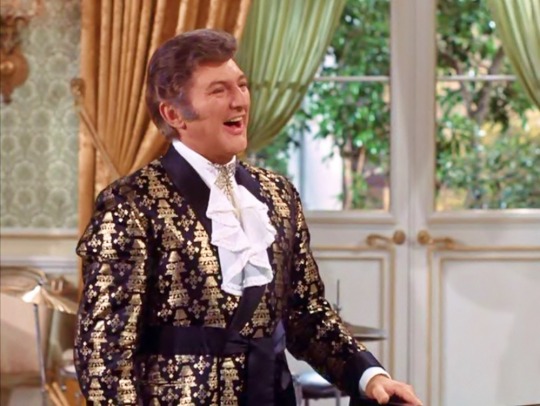
Liberace (Himself) was born Władziu Valentino Liberace in 1919. A piano prodigy, he was the son of working-class immigrants, and enjoyed a career spanning four decades of concerts, recordings, television, motion pictures, and endorsements. At the height of his fame, from the 1950s to the 1970s, Liberace was the highest-paid entertainer in the world, with established residencies in Las Vegas, and an international touring schedule.

Liberace (known informally as ‘Lee’) embraced a lifestyle of flamboyant excess both on and off stage, acquiring the sobriquet "Mr. Showmanship." Prior to this episode, his only appearance with Lucille Ball was the musical film Best Foot Forward (1943). He died at age 67 after a battle with HIV/AIDS.
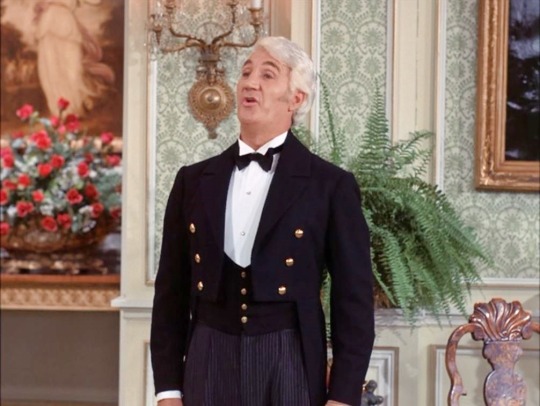
Ben Wrigley (Williams, Liberace's Butler) was a British actor who appeared in My Fair Lady (1964) and Bednobs and Broomsticks (1971). He previously appeared as a ticket agent in “Lucy Flies to London” (TLS S5;E6). This is the first of his three episodes of “Here’s Lucy.”
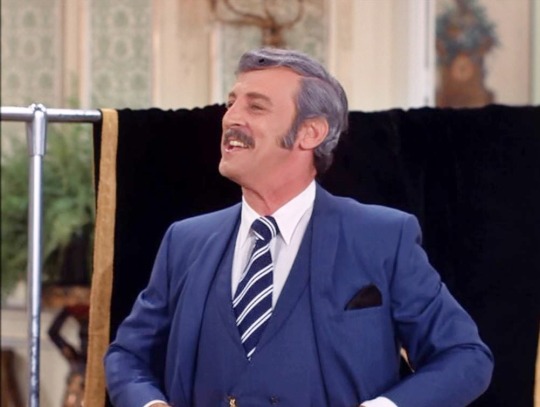
Paul Winchell (Carlo, Liberace's Tailor) previously played himself in“Lucy and Paul Winchell” (TLS S5;E4). He was born Paul Wilchinsky in 1922. Coming into the public eye in 1948, he became one of the most famous ventriloquists since Edgar Bergen. He hosted the enormously popular children’s television show “Winchell-Mahoney Time” (1964-68) in which he shared the spotlight with Jerry Mahoney, one of his most popular characters. He played Doc Putnam in “Main Street U.S.A.” (TLS S5;17) and “Lucy Puts Main Street on the Map” (TLS S5;E18). This is the second of his two episodes of “Here’s Lucy.” He died in 2005.
Winchell uses an Italian accent for this character.

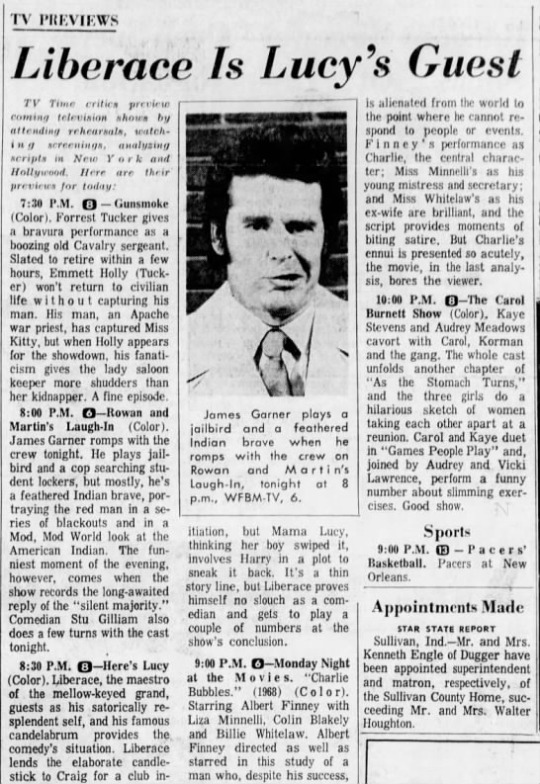
This is the first episode of the new year and the new decade.

The 1970s will see the end of “Here's Lucy” in 1974, as well as Lucille Ball's return to the silver screen in Mame that same year. In 1971, Lucie Arnaz will wed Phil Vandervort and Desi Arnaz Jr. made his big screen debut in Red Sky at Morning. At the end of the decade, Lucie Arnaz made her Broadway debut in They're Playing Our Song (1979).
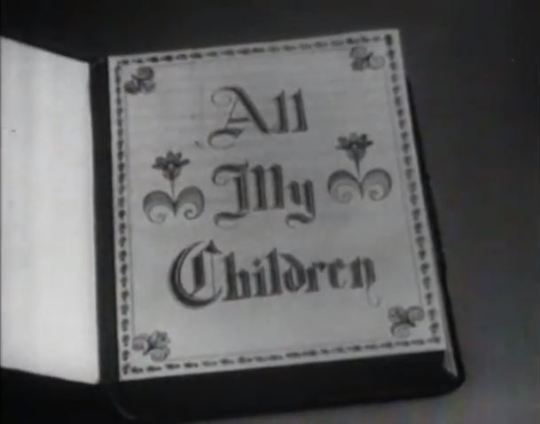
The date this episode was first aired (January 5, 1970) ABC premiered a new daytime drama called All My Children. Philip Amelio, who played Lucy’s grandson on “Life With Lucy”, appeared on the sudser in 1988. It ceased production in 2013.


Liberace brought $50,000 worth of his spectacular wardrobe to the set, and Lucille Ball hired a round-the-clock security guard to ensure its safety. The tuxedo jacket that lights up in the dark made its debut on this show; Liberace will use it in his act for the rest of his life.

In the 2013 HBO biopic Behind the Candelabra, an aging Liberace (Michael Douglas) compares his domestic life with partner Scott Thorson (Matt Damon) to an old sitcom. Scott protests: “Why am I the Lucy?” Douglas' father Kirk made a wordless cameo appearance on a 1966 episode of “The Lucy Show.”
Professor Harkens gave Craig the African mask.

Lucy recalls her initiation into ‘The Swingers’ in high school. The double entendre of 'swinging' is quickly cleared up by Lucy saying she was in a trapeze club! For her initiation, she had to get an autographed photo of Rudy Vallee. Rudy Vallee was a singer popular in the 1920s and '30s who made a guest appearance on the first episode of “The Lucy-Desi Comedy Hour” in 1957. He will guest star as himself during season 3 of “Here's Lucy.”

Kim guesses that Craig may have to retrieve an item from Engelbert Humperdinck. Lucy replies “What's an Engelbert Dumperhinck?” Engelbert Humperdinck is an English pop singer acclaimed as one of the finest middle-of-the-road balladeers around. In 1969 he released two albums and had three hit singles. That same year he was the first guest on “The Liberace Show”.
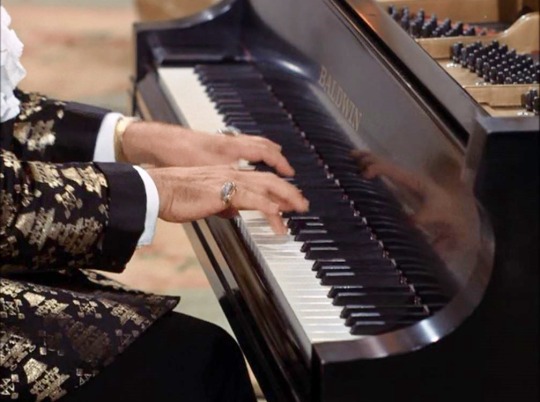
In Liberace's mansion, he enters and sits at a glass-lid Baldwin grand piano and plays Chopin's “Military Polonaise” (Opus 40, #1) composed in 1838.

When Liberace tries on the light-up jacket, he says “This'll really turn them on in Pasadena!” He could be referring to his senior citizen female fans. There was a popular song at the time titled “Little Old Lady From Pasadena.” Later in the episode we learn that the candelabra loaned to Craig was a gift from a Senior Citizen group.

In a retrospectively ironic line, Liberace says about his many candelabras: “I've got closets full of them.” Although Liberace was flamboyant, his sexual orientation was never discussed publicly (he was ‘in the closet’) until later in his life. When 17 year-old Craig and Liberace are alone (and Craig's shirt is unbuttoned to the navel) it is difficult not to think of Liberace's romance with 18 year-old Scott Thorson (inset), who later sued the entertainer in America's first same-sex palimony case.
At home, Craig gets a phone call from Bill. This is probably a nod to Desi Arnaz Jr.'s friend and band mate Billy Hinsche.

Answering the front door, Kim says “It's probably Craig with his arms loaded down with that something he had to get from a big star.” Lucy replies: “Maybe he's got his arms full of Jackie Gleason.” This is a quick joke about comedy star Jackie Gleason's weight. Gleason did a cameo as Ralph Kramden in the second episode of “Here's Lucy” (above).

Harry is reminded that in college he underwent initiation into the fraternity Delta Delta Tau. The joke comes when he gives says their initials – DDT. Dichlorodiphenyltrichloroethane (DDT) is a chemical used as an insecticide. In the late 1960s and early ‘70s DDT was frequently in the news regarding its harmful effects on humans, wildlife, and the environment. DDT was eventually banned.
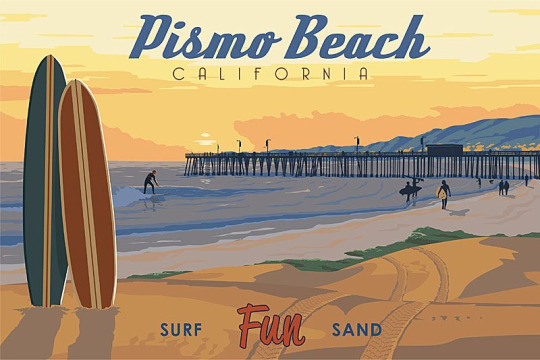
The candelabra is inscribed “To Liberace. From his Senior Citizen Fan Club in Pismo Beach.” Along with Cucagmonga, Pismo Beach was often used as a punch-line for jokes about California. It was mentioned in “Lucy Goes on Strike” (S1;E16). Pismo Beach is one of the locations Lucy and Ethel want to visit before returning to New York in “Lucy Gets Into Pictures” (ILL S4;E18).

On their way to return the candelabra to Liberace, Harry holds it forth and says “Lead, kindly light.” “Lead, Kindly Light” is a hymn with words written in 1833 by John Henry Newman as a poem titled "The Pillar of Cloud."

Sneaking into Liberace's mansion through the back door, Harry's shoes squeak! Lucy says “You'd sure be a goofball on 'Mission: Impossible.’” The Desilu TV spy show “Mission: Impossible” has been a source of humor for “Here's Lucy,” which even did a whole episode parodying the show: “Lucy's Impossible Mission” (S1;E6, above).

Harry and Lucy sing while Liberace plays "By the Light of the Silvery Moon,” a song written in 1909 by Gus Edwards and Edward Madden. Lucy says she and Harry first performed the number at the Kiwanis Capers.

When Lucy suggests that Liberace use the whole family on his TV special, Liberace remarks “You're about 83 short of the King Family.” The King Family was a family musical group that had great success on records and television in the 1960s. They had a TV show on ABC that ran until 1969.
As the big finale, everyone sings and dances to "I'll Be Seeing You," a song written by Sammy Fain and Irving Kahal in 1938. It was inserted into the Broadway musical Right This Way, which closed after just fifteen performances.


Lucy and Lee shared the covers of many periodicals of the 1950s. Both had top-rated television programs and were instantly identifiable figures and names. Nearly 20 years later, both are still considered show business royalty.

Offscreen, Lucy and Desi socialize with Liberace during the height of their fame.
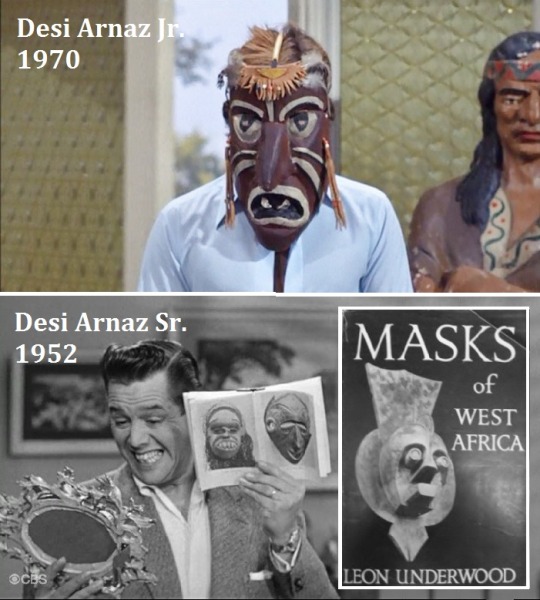
At the start of the episode, Craig enters wearing an African mask. The moment is similar to when Ricky Ricardo researched African masks for his Voodoo act during “Lucy Goes to the Hospital” (ILL S2;E16). The scene also begins the 1953 episode. Ricky Ricardo also briefly wore an African mask in “Cuban Pals” (ILL S1;E28) before singing “Similau.”
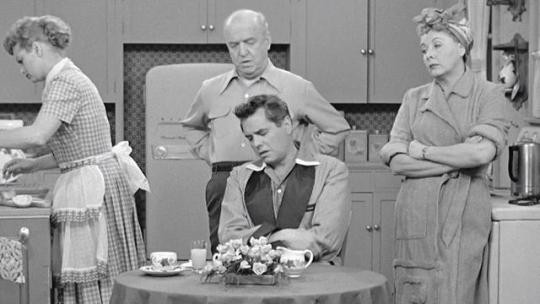
Liberace tells Craig not to worry about returning the candelabra as he has a lot of them. Craig replies: “If Los Angeles ever had a black out – you could light the whole city.” This echoes when Liberace was first mentioned by Lucy Ricardo in “The Diner” (ILL S3;E25) in 1954.
LUCY RICARDO: (about Ricky’s bad mood): “Everything went wrong down at the club last night. Right in the middle of his big number, the lights went out all over the whole neighborhood. Everybody got up and, and left and went into the nightclub across the street.”
ETHEL MERTZ: “How’d they manage without electricity?”
LUCY RICARDO: “Liberace was playing there. He does his show by candlelight.”

“Lucy’s Club Dance” (S3;E25) included the February 26, 1954 issue of TV Guide with Liberace (and a candelabra) on the cover. It was one of many used as set dressing for a corner news stand.
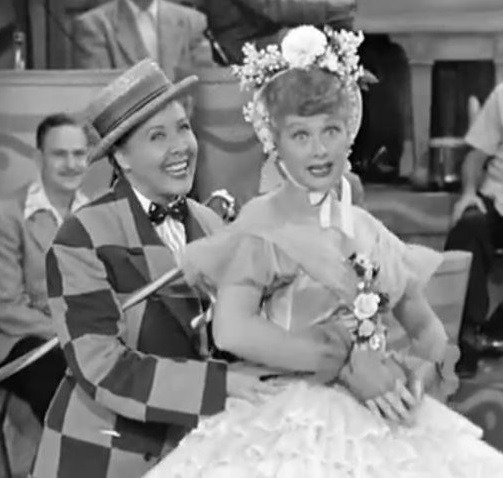
In “Lucy’s Show-Biz Swan Song” (ILL S2;E12) Lucy and Ethel sing “By the Light of the Silvery Moon” and wangles her way into performing with a barbershop quartet.

In “Lucy’s Barbershop Quartet” (TLS S1;E19) Lucy Carmichael and Vivian Bagley sing “By the Light of the Silvery Moon” and wangles her way into performing with a barbershop quartet.
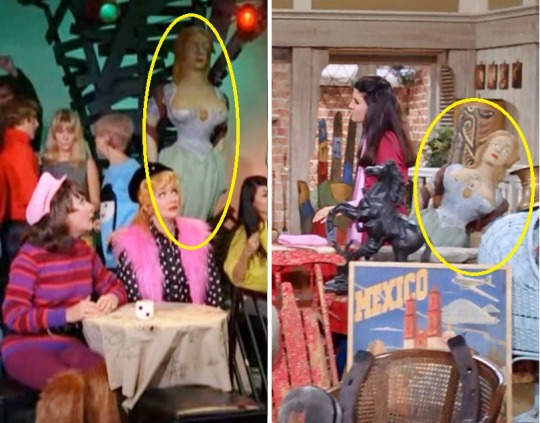
Craig's collectibles are no doubt supplied by prop master Kenneth Westcott from the Desilu props supply. It is likely that all of the items were used in some television program, but the one most recognizable is the female ship's figurehead. It was last seen in the background of the Sunset Strip beatnik hangout in “Viv Visits Lucy” (TLS S5;E15).
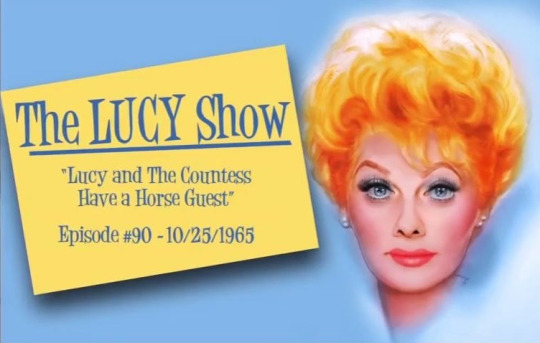
In “Lucy and the Countess Have a Horse Guest” (TLS S4;E6), Lucy Carmichael tells the Countess (aka her old chum Rosie) that since moving to Hollywood she has met Lassie’s hairdresser, the man who used to dry off Lloyd Bridges, and Liberace’s dentist. Liberace was well known for his continual smile.
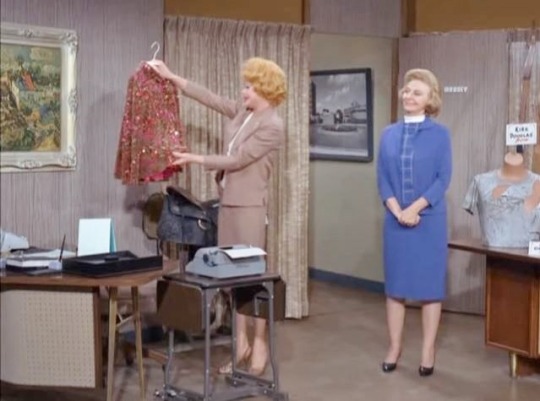
In “Lucy Dates Dean Martin” (TLS S4;E21) Lucy Carmichael admires (and later wears) a sequined top once worn by Audrey Hepburn. Dean Martin says “The last time I saw anything that fancy was on Liberace.” In “Lucy and Liberace” Harry admires and tries on Liberace’s red sequined jacket.

Math Fail! Liberace says that the Carters are 83 short of the King Family. There were 39 members of the King family, ranging in age from 7 months to 79 years, who appeared on their television show. Liberace is exaggerating by 48 Kings!

Where the (Marble) Floor Ends! In the living room scene the camera pulls back to far and reveals the soundstage cement floor. When this happens in Liberace's mansion, the tape spike marks are clearly visible for centering of the dance numbers and camera positions.
Sitcom Logic Alert! The ending of the episode ditches all pretense of reality and turns into a musical performance for the studio audience, including Liberace waving to the audience as he exits – stage right! It is jarring and a sign that – once again - “Here's Lucy” is unsure of its identity.

“Lucy and Liberace” rates 3 Paper Hearts out of 5
Let's face it – even playing himself Liberace is a pretty mediocre actor, so this episode could never be more than a showcase for his talent and opulent wardrobe on which is hung a paper thin plot. The worst thing about the episode is the complete demolishing of the fourth wall during the final number. Shameless, really.
#Here's Lucy#Lucille Ball#Liberace#Lucie Arnaz#Gale Gordon#Desi Arnaz Jr.#Candelabra#Behind the Candelabra#Chopin Military Polonaise#I'll Be Seeing You#By the light of the Silvery Moon#The King Family#Paul Winchell#Ben Wrigley#Jack Baker#Seaman Jacobs#Fred S. Fox#Rudy Vallee#Engelbert Humperdinck#Billy Hinsche#Scott Thorson#Michael Douglas#DDT#Kenneth Westcott#Jackie Gleason#Lead Kindly Light#Mission Impossible#TV#1970#CBS
7 notes
·
View notes